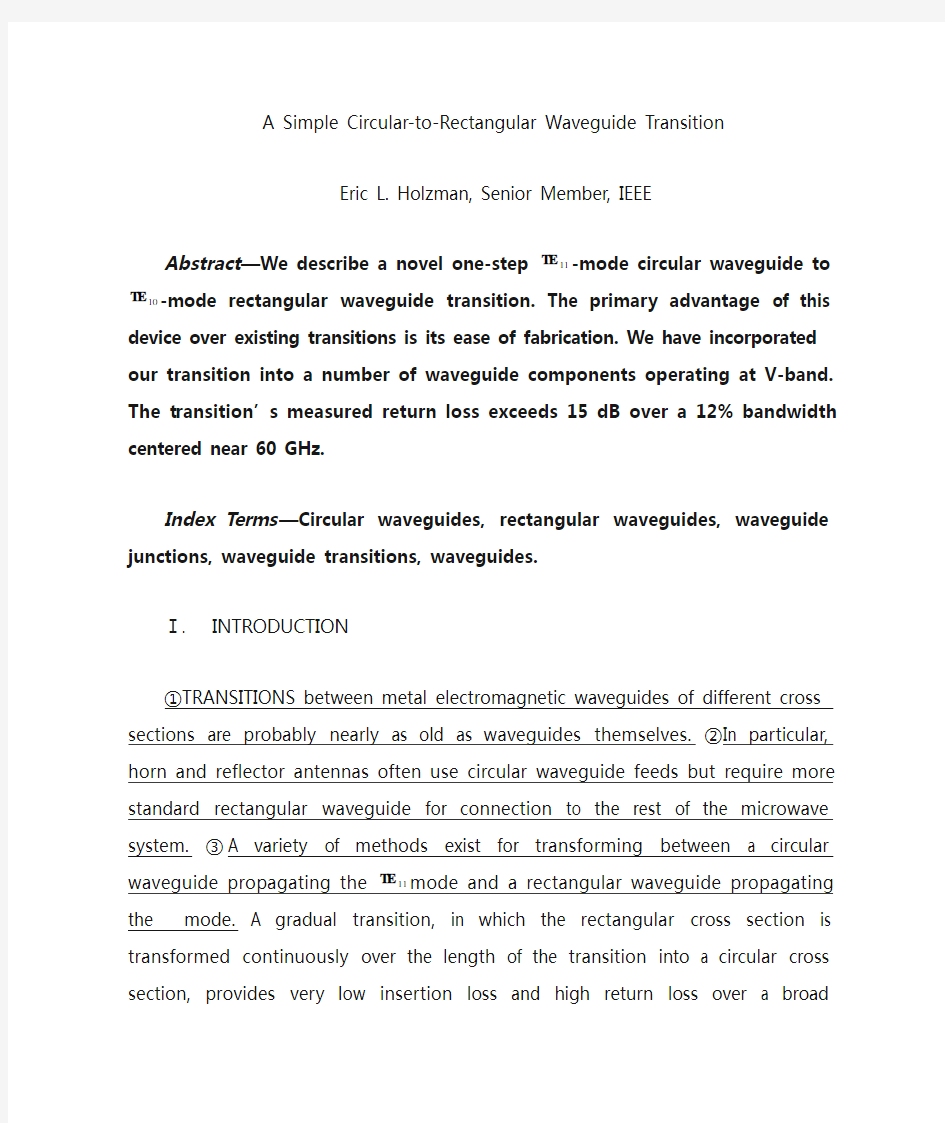西安电子科技大学研究生专业英语文献翻译大作业样例

- 1、下载文档前请自行甄别文档内容的完整性,平台不提供额外的编辑、内容补充、找答案等附加服务。
- 2、"仅部分预览"的文档,不可在线预览部分如存在完整性等问题,可反馈申请退款(可完整预览的文档不适用该条件!)。
- 3、如文档侵犯您的权益,请联系客服反馈,我们会尽快为您处理(人工客服工作时间:9:00-18:30)。
A Simple Circular-to-Rectangular Waveguide Transition
Eric L. Holzman, Senior Member, IEEE
Abstract —We describe a novel one-step 11T E -mode circular waveguide to 10T E -mode rectangular waveguide transition. The primary advantage of this device over existing transitions is its ease of fabrication. We have incorporated our transition into a number of waveguide components operating at V-band. The transition’s measured return loss exceeds 15 dB over a 12% bandwidth c entered near 60 GHz.
Index Terms —Circular waveguides, rectangular waveguides, waveguide junctions, waveguide transitions, waveguides.
Ⅰ. INTRODUCTION
①TRANSITIONS between metal electromagnetic waveguides of different cross sections are probably nearly as old as waveguides themselves. ②In particular, horn and reflector antennas often use circular waveguide feeds but require more standard rectangular waveguide for connection to the rest of the microwave system. ③A variety of methods exist for transforming between a circular waveguide propagating the 11T E mode and a rectangular waveguide propagating the mode. A gradual
transition, in which the rectangular cross section is transformed continuously over the length of the transition into a circular cross section, provides very low insertion loss and high return loss over a broad bandwidth, but is relatively long. ④The bandwidth of a stepped transition, in which the rectangular waveguide is matched to the circular waveguide via one or more intermediate structures of constant cross section, increases with the number of steps [1]–[5]. We also can butt the rectangular and circular
waveguides directly together with an iris at the junction for matching [6]. ⑤All these structures require a significant amount of precision machining, especially in the millimeter-wave bands, where the waveguide dimensions are small.
We describe a simple, easy-to-implement, one-step transition for dominant mode circular to rectangular waveguide. ⑥The transition requires a single machining operation to fabricate. Our design appears to be novel.
Ⅱ. CONCEPT
⑦Fig. 1 shows a conventional one-step circular-to-rectangular waveguide transition, much like that described in [5]. Typically, the step is the output of the component with the circular waveguide. ⑧The circular waveguide has a diameter that is greater than the height of standard rectangular waveguide if we are to operate at least 10% above the 11T E mode cutoff frequency. ⑨Thus, to machine a one-step transition out of a block of metal, the circular waveguide is drilled from one end a precisely controlled depth, leaving exactly enough distance to machine the transition step from the other end of the block.
Ourtransition, shownin Fig. 2, is much simpler to fabricate. We drill the circular waveguide completely through the metal block fromeitherside. Then we machine the transition slot to the desired end of the block in a single operation. ⑩This transition
